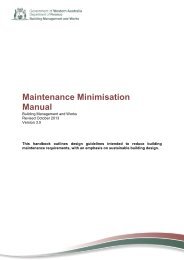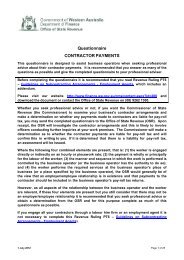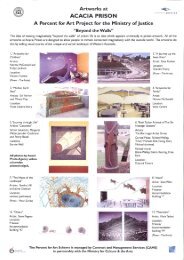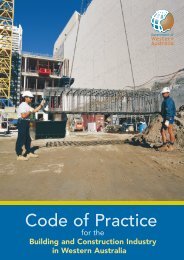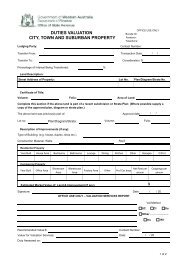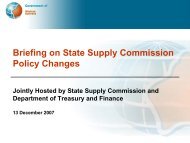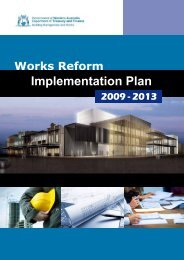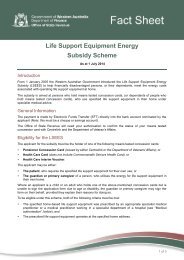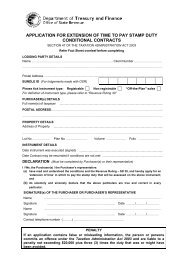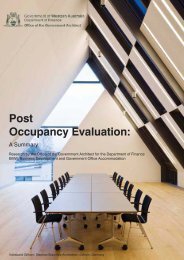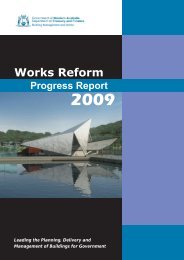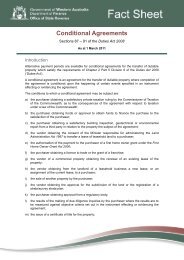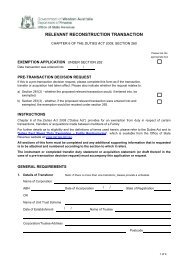Renewable Energy Handbook 2010 - Department of Finance - The ...
Renewable Energy Handbook 2010 - Department of Finance - The ...
Renewable Energy Handbook 2010 - Department of Finance - The ...
Create successful ePaper yourself
Turn your PDF publications into a flip-book with our unique Google optimized e-Paper software.
46RENEWABLE ENERGY BACKGROUNDOFFICE OF ENERGYRENEWABLE ENERGY HANDBOOK <strong>2010</strong>A 1.1 Wind <strong>Energy</strong>A 1.1.1 INTRODUCTION<strong>The</strong>re are two types <strong>of</strong> towers used in modernWind power is one <strong>of</strong> the most advanced andwind turbines – enclosed, tubular, steel towers andcommercially available <strong>of</strong> renewable energyan open steel lattice tower. Only the tubular towertechnologies. Commercial-scale wind-generated is used in Australia, as although they are moreelectricity has, however, only emerged in the past two expensive, they are more aesthetically pleasing,decades, particularly in Northern Europe. Wind energy provide better protection for equipment and personnelis a major source <strong>of</strong> power in over 70 countries across and have no perching platforms for birds.the world. Globally, installed wind energy capacity grewA 1.1.3 CAPACITY FACTORby 28 per cent in 2008, compared to 2007, makingwind energy the fastest-growing electricity source. Capacity factor is one element in measuring theproductivity <strong>of</strong> a wind turbine or any other powerIn Australia, even higher growth rates have beenproduction facility. It compares the plant’s actualachieved with a total installed wind capacity at theproduction over a given period <strong>of</strong> time with the amountend <strong>of</strong> 2008 <strong>of</strong> 1306 MW, a 37 percent rise on 2007.<strong>of</strong> power the plant would have produced if it hadIn 2009, a number <strong>of</strong> new wind farms wererun at full capacity for the same amount <strong>of</strong> time.commissioned, increasing total operating capacity<strong>of</strong> 1476 MW.<strong>Energy</strong> from high-quality modern wind turbinesCapacity Factor =has become one <strong>of</strong> the cheaper renewable energytechnologies. Large-scale wind energy projects cancost as little as two to three cents more per kilowatthour above the national electricity market pool prices.Modern utility-scale wind turbines typically haveA 1.1.2 TECHNICAL INFORMATIONoverall capacity factors <strong>of</strong> 20 per cent to 40 per cent,Wind energy is a proven, mature and internationally depending on the average energy that is availableestablished technology. Modularity and a short in the prevailing wind conditions. In comparison,construction period are positive features <strong>of</strong> wind farms. a capacity factor <strong>of</strong> 40 per cent to 80 per cent is<strong>The</strong> greatest challenge to the economic use <strong>of</strong> wind typical for conventional electricity generators,power is its variability. <strong>Energy</strong> storage, or a backup however this is normally not limited by the generatorsystem, is required for <strong>of</strong>f-grid systems for extremely itself, but a consequence <strong>of</strong> how the generator iswindy or windless periods, and also to level the supply dispatched to meet system demand.even when the wind is blowing. Managing variabilityAvailability factor (or just “availability”), on thecan be a challenge for network operators requiringother hand, is a measurement <strong>of</strong> the reliability <strong>of</strong>ancillary services to compensate and to providea wind turbine or other power plant. It refers to thecontinuous automatic voltage adjustments.percentage <strong>of</strong> time that a plant is ready to generateHorizontal-axis turbines are the most commercially (i.e., not out <strong>of</strong> service for maintenance or repairs).successful wind technology. <strong>The</strong> most signifi cant trend Modern wind turbines have an availability <strong>of</strong> morein this technology has been the continuing increase in than 98 per cent, which is higher than most otherthe size <strong>of</strong> individual machines. This means that more types <strong>of</strong> power plant.power can potentially be produced by fewer turbines.<strong>The</strong> turbine will generally consist <strong>of</strong> the followingcomponents:· Rotor;· Generator;Directional system;·Protection system; and·· Tower.Actual amount <strong>of</strong> power produced over timePower that would have been produced if turbine operatedat maximum output 100 percent <strong>of</strong> the time



